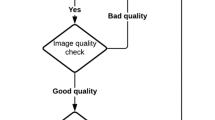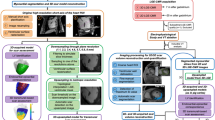Abstract
Reentrant ventricular tachycardia is the next emerging frontier in electrophysiology. Current ablation strategies rely on endocardial voltage measurements to identify myocardial scar and guide catheter ablation procedures. However, this voltage mapping approach has several inherent limitations. In patients with structural heart disease, positron emission tomography (PET)/CT has the potential to provide supplementary scar characterization by displaying additional metabolic (by PET) and morphologic (by CT) tissue-specific information. Three-dimensional scar maps can be created from the imaging datasets, which are uploaded into clinical mapping systems, and can facilitate substrate-guided ablation procedures. This has the potential to shorten procedure times, decrease complications, and improve the procedural success.
Similar content being viewed by others
References and Recommended Reading
McCullough PA, Philbin EF, Spertus JA, et al.: Confirmation of a heart failure epidemic: findings from the Resource Utilization Among Congestive Heart Failure (REACH) study. J Am Coll Cardiol 2002, 39:60–69.
Redfield MM: Heart failure—an epidemic of uncertain proportions. N Engl J Med 2002, 347:1442–1444.
Bardy GH, Lee KL, Mark DB, et al.: Amiodarone or an implantable cardioverter-defibrillator for congestive heart failure. N Engl J Med 2005, 352:225–237.
Moss AJ, Zareba W, Hall WJ, et al.: Prophylactic implantation of a defibrillator in patients with myocardial infarction and reduced ejection fraction. N Engl J Med 2002, 346:877–883.
Morady F, Harvey M, Kalbfleisch SJ, et al.: Radiofrequency catheter ablation of ventricular tachycardia in patients with coronary artery disease. Circulation 1993, 87:363–372.
Stevenson WG, Khan H, Sager P, et al.: Identification of reentry circuit sites during catheter mapping and radiofrequency ablation of ventricular tachycardia late after myocardial infarction. Circulation 1993, 88:1647–1670.
Marchlinski FE, Callans DJ, Gottlieb CD, Zado E: Linear ablation lesions for control of unmappable ventricular tachycardia in patients with ischemic and nonischemic cardiomyopathy. Circulation 2000, 101:1288–1296.
Hunold P, Schlosser T, Vogt FM, et al.: Myocardial late enhancement in contrast-enhanced cardiac MRI: distinction between infarction scar and non-infarction-related disease. AJR Am J Roentgenol 2005, 184:1420–1426.
de Bakker JM, van Capelle FJ, Janse MJ, et al.: Reentry as a cause of ventricular tachycardia in patients with chronic ischemic heart disease: electrophysiologic and anatomic correlation. Circulation 1988, 77:589–606.
de Bakker JM, van Capelle FJ, Janse MJ, et al.: Slow conduction in the infarcted human heart. ‘Zigzag’ course of activation. Circulation 1993, 88:915–926.
Nazarian S, Bluemke DA, Lardo AC, et al.: Magnetic resonance assessment of the substrate for inducible ventricular tachycardia in nonischemic cardiomyopathy. Circulation 2005, 112:2821–2825.
Stevenson WG, Friedman PL, Kocovic D, et al.: Radiofrequency catheter ablation of ventricular tachycardia after myocardial infarction. Circulation 1998, 98:308–314.
Oza S, Wilber DJ: Substrate-based endocardial ablation of postinfarction ventricular tachycardia. Heart Rhythm 2006, 3:607–609.
Verma A, Marrouche NF, Schweikert RA, et al.: Relationship between successful ablation sites and the scar border zone defined by substrate mapping for ventricular tachycardia post-myocardial infarction. J Cardiovasc Electrophysiol 2005, 16:465–471.
Gepstein L, Hayam G, Ben Haim SA: A novel method for nonfluoroscopic catheter-based electroanatomical mapping of the heart. In vitro and in vivo accuracy results. Circulation 1997, 95:1611–1622.
Kim RJ, Fieno DS, Parrish TB, et al.: Relationship of MRI delayed contrast enhancement to irreversible injury, infarct age, and contractile function. Circulation 1999, 100:1992–2002.
Lima JA, Judd RM, Bazille A, et al.: Regional heterogeneity of human myocardial infarcts demonstrated by contrastenhanced MRI. Potential mechanisms. Circulation 1995, 92:1117–1125.
Rehwald WG, Fieno DS, Chen EL, et al.: Myocardial magnetic resonance imaging contrast agent concentrations after reversible and irreversible ischemic injury. Circulation 2002, 105:224–229.
Faris OP, Shein M: Food and Drug Administration perspective: magnetic resonance imaging of pacemaker and implantable cardioverter-defibrillator patients. Circulation 2006, 114:1232–1233.
Marckmann P, Skov L, Rossen K, et al.: Nephrogenic systemic fibrosis: suspected causative role of gadodiamide used for contrast-enhanced magnetic resonance imaging. J Am Soc Nephrol 2006, 17:2359–2362.
Lardo AC, Cordeiro MA, Silva C, et al.: Contrast-enhanced multidetector computed tomography viability imaging after myocardial infarction: characterization of myocyte death, microvascular obstruction, and chronic scar. Circulation 2006, 113:394–404.
Mahnken AH, Koos R, Katoh M, et al.: Assessment of myocardial viability in reperfused acute myocardial infarction using 16-slice computed tomography in comparison to magnetic resonance imaging. J Am Coll Cardiol 2005, 45:2042–2047.
Brunken R, Tillisch J, Schwaiger M, et al.: Regional perfusion, glucose metabolism, and wall motion in patients with chronic electrocardiographic Q wave infarctions: evidence for persistence of viable tissue in some infarct regions by positron emission tomography. Circulation 1986, 73:951–963.
Maes A, Flameng W, Nuyts J, et al.: Histological alterations in chronically hypoperfused myocardium. Correlation with PET findings. Circulation 1994, 90:735–745.
Tamaki N, Kawamoto M, Tadamura E, et al.: Prediction of reversible ischemia after revascularization. Perfusion and metabolic studies with positron emission tomography. Circulation 1995, 91:1697–1705.
Yoshida K, Gould KL: Quantitative relation of myocardial infarct size and myocardial viability by positron emission tomography to left ventricular ejection fraction and 3-year mortality with and without revascularization. J Am Coll Cardiol 1993, 22:984–997.
Jain D, Strauss HW: Principles of cardiovascular imaging. In Atlas of Nuclear Cardiology. Edited by Dilsizian V, Narula J. Philadelphia: Current Medicine; 2003:1–19.
Chareonthaitawee P, Schaefers K, Baker CS, et al.: Assessment of infarct size by positron emission tomography and [18F]2-fluoro-2-deoxy-D-glucose: a new absolute threshold technique. Eur J Nucl Med Mol Imaging 2002, 29:203–215.
Higuchi T, Nekolla SG, Jankaukas A, et al.: Characterization of normal and infarcted rat myocardium using a combination of small-animal PET and clinical MRI. J Nucl Med 2007, 48:288–294.
Berry JJ, Hoffman JM, Steenbergen C, et al.: Human pathologic correlation with PET in ischemic and nonischemic cardiomyopathy. J Nucl Med 1993, 34:39–47.
Kuhl HP, Beek AM, van der Weerdt AP, et al.: Myocardial viability in chronic ischemic heart disease: comparison of contrast-enhanced magnetic resonance imaging with (18)F-fluorodeoxyglucose positron emission tomography. J Am Coll Cardiol 2003, 41:1341–1348.
Kornowski R, Hong MK, Leon MB: Comparison between left ventricular electromechanical mapping and radionuclide perfusion imaging for detection of myocardial viability. Circulation 1998, 98:1837–1841.
Gyongyosi M, Sochor H, Khorsand A, et al.: Online myocardial viability assessment in the catheterization laboratory via NOGA electroanatomic mapping: quantitative comparison with thallium-201 uptake. Circulation 2001, 104:1005–1011.
Fuchs S, Hendel RC, Baim DS, et al.: Comparison of endocardial electromechanical mapping with radionuclide perfusion imaging to assess myocardial viability and severity of myocardial ischemia in angina pectoris. Am J Cardiol 2001, 87:874–880.
Gyongyosi M, Khorsand A, Sochor H, et al.: Characterization of hibernating myocardium with NOGA electroanatomic endocardial mapping. Am J Cardiol 2005, 95:722–728.
Koch KC, vom DJ, Wenderdel M, et al.: Myocardial viability assessment by endocardial electroanatomic mapping: comparison with metabolic imaging and functional recovery after coronary revascularization. J Am Coll Cardiol 2001, 38:91–98.
Botker HE, Lassen JF, Hermansen F, et al.: Electromechanical mapping for detection of myocardial viability in patients with ischemic cardiomyopathy. Circulation 2001, 103:1631–1637.
Keck A, Hertting K, Schwartz Y, et al.: Electromechanical mapping for determination of myocardial contractility and viability. A comparison with echocardiography, myocardial single-photon emission computed tomography, and positron emission tomography. J Am Coll Cardiol 2002, 40:1067–1074.
Wiggers H, Botker HE, Sogaard P, et al.: Electromechanical mapping versus positron emission tomography and single photon emission computed tomography for the detection of myocardial viability in patients with ischemic cardiomyopathy. J Am Coll Cardiol 2003, 41:843–848.
Callans DJ, Ren JF, Michele J, et al.: Electroanatomic left ventricular mapping in the porcine model of healed anterior myocardial infarction. Correlation with intracardiac echocardiography and pathological analysis. Circulation 1999, 100:1744–1750.
Gepstein L, Goldin A, Lessick J, et al.: Electromechanical characterization of chronic myocardial infarction in the canine coronary occlusion model. Circulation 1998, 98:2055–2064.
Kornowski R, Hong MK, Gepstein L, et al.: Preliminary animal and clinical experiences using an electromechanical endocardial mapping procedure to distinguish infarcted from healthy myocardium. Circulation 1998, 98:1116–1124.
Shekhar R, Walimbe V, Raja S, et al.: Automated 3-dimensional elastic registration of whole-body PET and CT from separate or combined scanners. J Nucl Med 2005, 46:1488–1496.
Francone M, Carbone I, Danti M, et al.: ECG-gated multidetector row spiral CT in the assessment of myocardial infarction: correlation with non-invasive angiographic findings. Eur Radiol 2006, 16:15–24.
Nieman K, Cury RC, Ferencik M, et al.: Differentiation of recent and chronic myocardial infarction by cardiac computed tomography. Am J Cardiol 2006, 98:303–308.
Lessick J, Mutlak D, Rispler S, et al.: Comparison of multidetector computed tomography versus echocardiography for assessing regional left ventricular function. Am J Cardiol 2005, 96:1011–1015.
Gerber BL, Belge B, Legros GJ, et al.: Characterization of acute and chronic myocardial infarcts by multidetector computed tomography: comparison with contrast-enhanced magnetic resonance. Circulation 2006, 113:823–833.
Di Carli MF, Dorbala S, Meserve J, et al.: Clinical myocardial perfusion PET/CT. J Nucl Med 2007, 48:783–793.
Dickfeld T, Calkins H, Zviman M, et al.: Anatomic stereotactic catheter ablation on three-dimensional magnetic resonance images in real time. Circulation 2003, 108:2407–2413.
Dong J, Calkins H, Solomon SB, et al.: Integrated electroanatomic mapping with three-dimensional computed tomographic images for real-time guided ablations. Circulation 2006, 113:186–194.
Dong J, Dickfeld T, Dalal D, et al.: Initial experience in the use of integrated electroanatomic mapping with three-dimensional MR/CT images to guide catheter ablation of atrial fibrillation. J Cardiovasc Electrophysiol 2006, 17:459–466.
Dickfeld T, Lodge M, Voudouris A, et al.: Anatomic-metabolic scar imaging with positron emission tomography for guidance of ventricular tachycardia ablations. Heart Rhythm 2006, 3(1S):S74.
Dickfeld T, Voudouris A, Jeudy J, et al.: Fusion imaging with positron emission tomography/computer tomography (PET/CT) to guide ventricular tachycardia ablations. Circulation 2006, 114:3096.
Dickfeld T, Lei P, Dilsizian V, et al.: Integration of three-dimensional scar maps for ventricular tachycardia ablation with positron emission tomography-computed tomography. J Am Coll Cardiol 2008, In press.
Author information
Authors and Affiliations
Corresponding author
Rights and permissions
About this article
Cite this article
Dickfeld, T., Kocher, C. The role of integrated PET-CT scar maps for guiding ventricular tachycardia ablations. Curr Cardiol Rep 10, 149–157 (2008). https://doi.org/10.1007/s11886-008-0025-1
Published:
Issue Date:
DOI: https://doi.org/10.1007/s11886-008-0025-1




